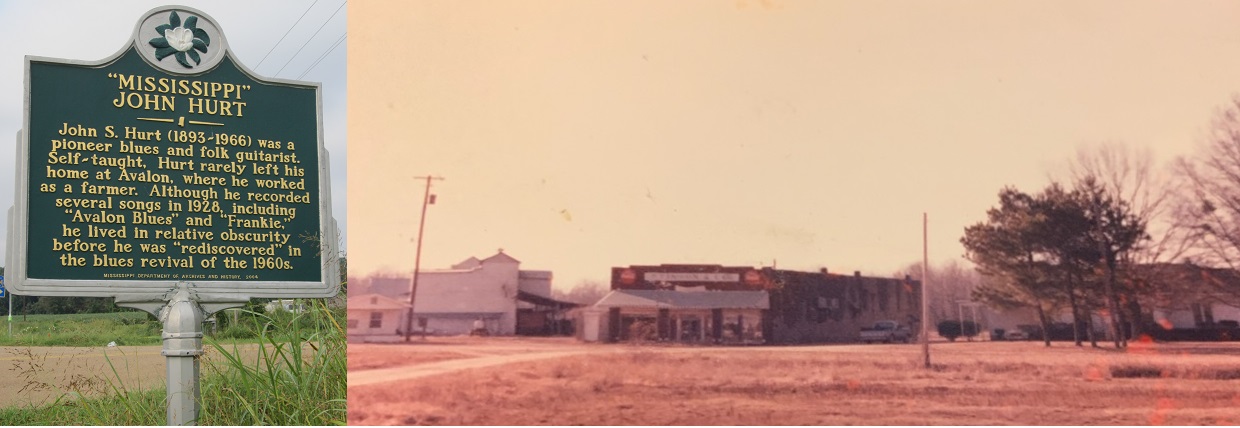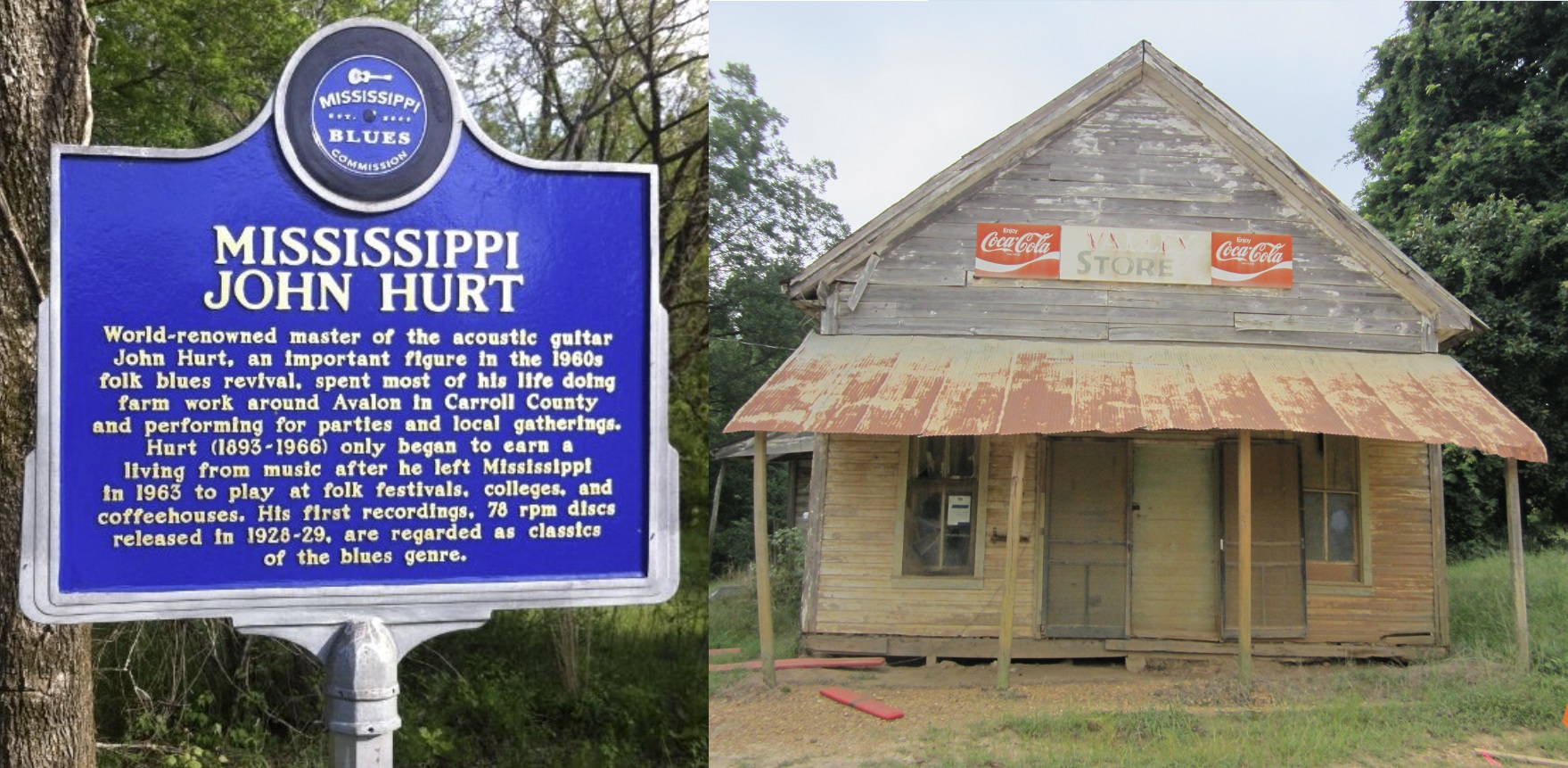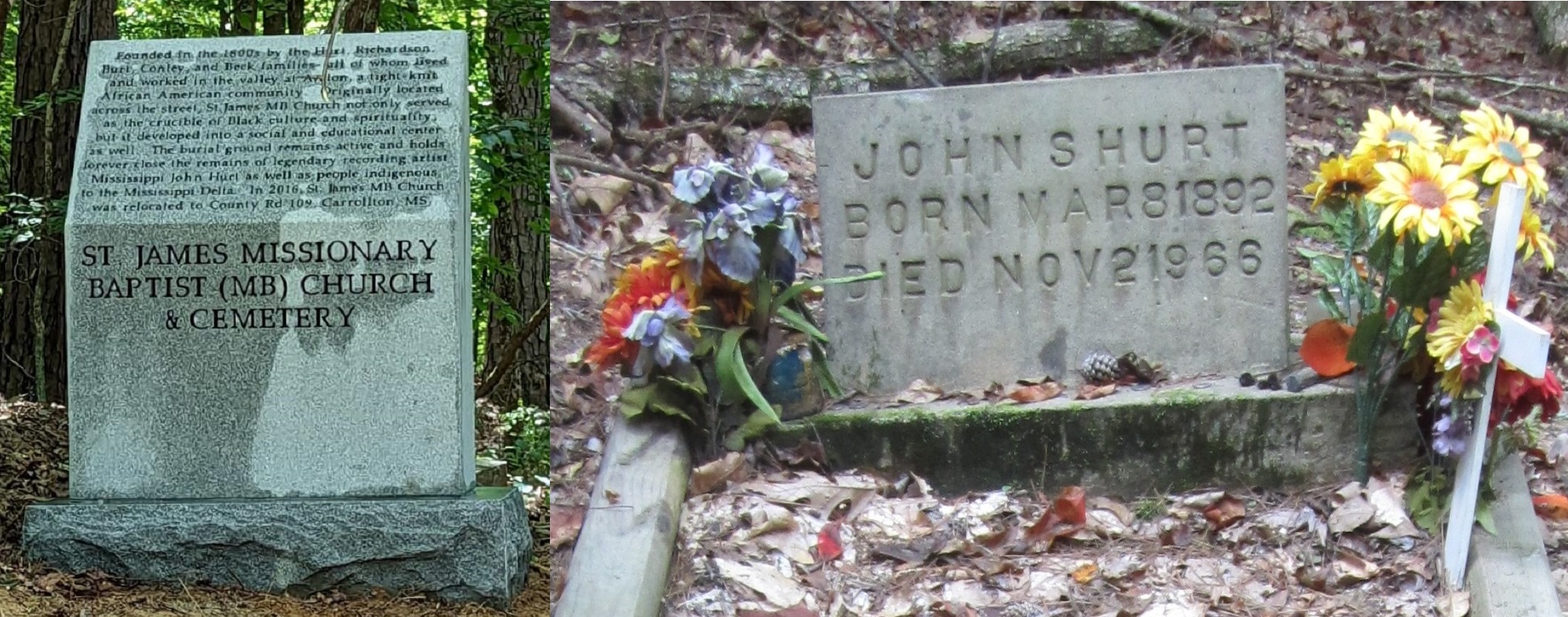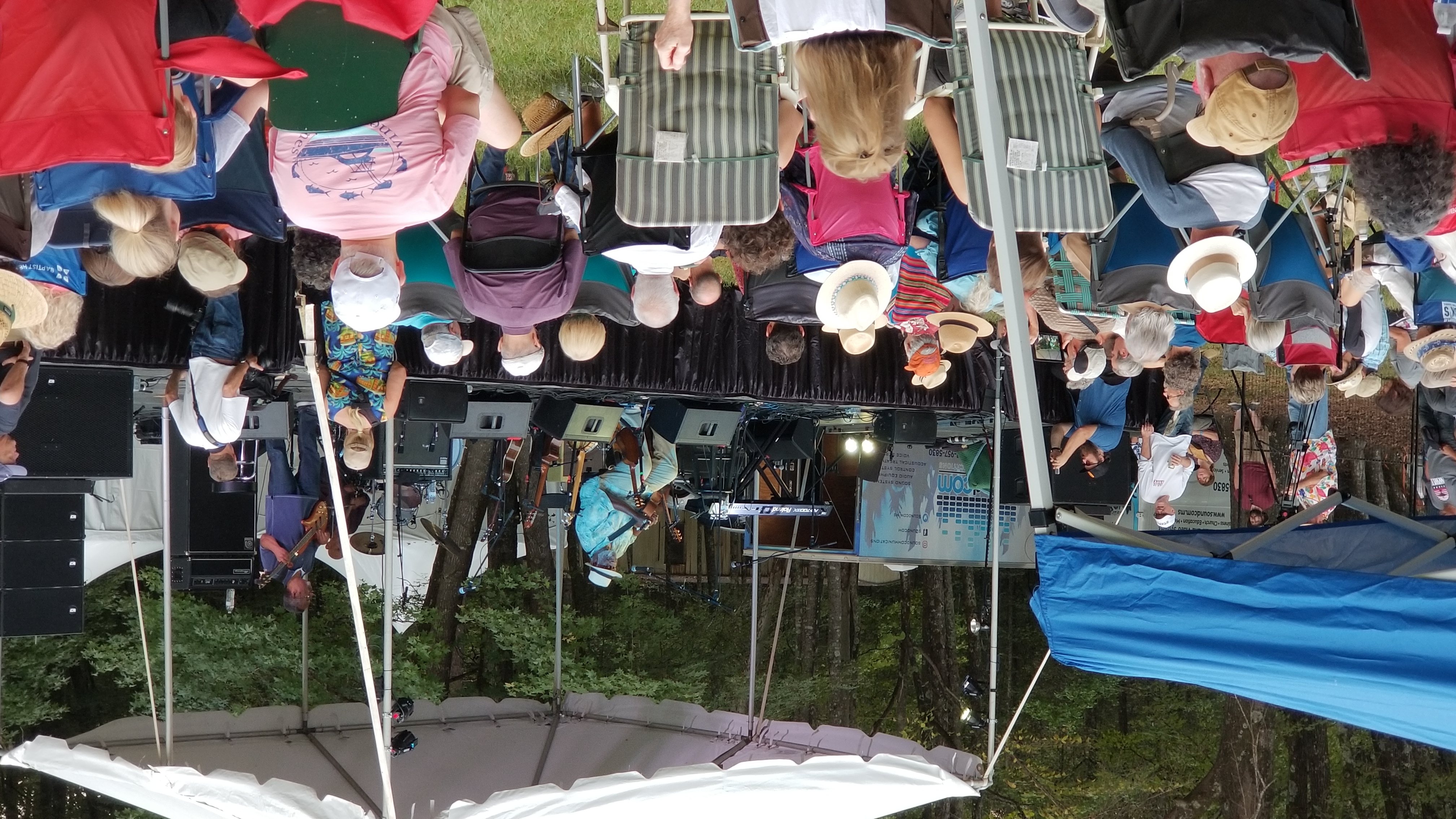AVALON, MY HOMETOWN
Even for seasoned “blues travelers,” there are destinations integral to the historical tapestry of early African-American music that unfortunately languish in obscurity. For many, the “blues” conjures images of wide, endless cotton fields, cypress groves, and tin-roofed shacks withering under the blistering heat of the Mississippi summer. While these images are not unfounded, it is precisely this shared cultural image of the Mississippi Delta that draws attention away from other Blues sites that are equally meaningful to the story of this music. One of these places is Avalon, Mississippi, the hometown of an unsung hero of acoustic Folk and Blues music, Mississippi John Hurt. For any fan of Blues, history, and especially fans of Mississippi John Hurt, it is well worth a visit. Located halfway between Greenwood and Grenada, Avalon sits on the eastern edge of the Delta, in Carroll County.
And like John Hurt’s song “Avalon Blues” suggests, “New York’s a good town, but it’s not for mind.”
As such, John lived most of his life in Avalon, a town too small to even be listed on maps after the early 1900s.
Unlike the starkness of the empty fields and highways of the Mississippi Delta, Avalon is a forested area where the prime thoroughfares are still dirt roads, carved through hill country clay.
Making a right turn off of State Road # 7 and driving north from Greenwood, one must wind their way through a maze of old roads that bore silent witness to the passage of time, as horses and mule-drawn buggies gradually gave way to motor vehicles.
Located halfway between Greenwood and Grenada, Avalon sits on the eastern edge of the Delta, in Carroll County.
And like John Hurt’s song “Avalon Blues” suggests, “New York’s a good town, but it’s not for mind.”
As such, John lived most of his life in Avalon, a town too small to even be listed on maps after the early 1900s.
Unlike the starkness of the empty fields and highways of the Mississippi Delta, Avalon is a forested area where the prime thoroughfares are still dirt roads, carved through hill country clay.
Making a right turn off of State Road # 7 and driving north from Greenwood, one must wind their way through a maze of old roads that bore silent witness to the passage of time, as horses and mule-drawn buggies gradually gave way to motor vehicles.
TAKE THE TOUR
 Many of the sites in Avalon that relate to Mississippi John Hurt are described on this page.
Fans of John Hurt will want to explore them and, because these points of interest are not so easy to find, it is highly recommended that first-time visitors make arrangements for a tour by contacting the Mississippi John Hurt Foundation.
Many of the sites in Avalon that relate to Mississippi John Hurt are described on this page.
Fans of John Hurt will want to explore them and, because these points of interest are not so easy to find, it is highly recommended that first-time visitors make arrangements for a tour by contacting the Mississippi John Hurt Foundation.
All tours are conducted by Floyd Bailey, a local businessman and former curator of the Mississippi John Hurt Museum. You can reach Mr. Bailey by sending your request to the Foundation at msjohnhurtfoundation@gmail.com.
Tours are donation-based (please be generous!) and visitors are encouraged to take photographs throughout.
THE AVALON
 The tour usually begins at the intersection of Highway 7 and County Road 204, where a marker was erected by the Mississippi Department of Archives and History to commemorate Mississippi John Hurt.
The marker represented the location of The Avalon, a mercantile store selling food, seeds, and clothing, and where John Hurt often performed, making The Avalon integral to his legend.
It also housed a bank and a post office and was the financial center of the Avalon community.
In this photograph from Mary Frances Hurt's private collection, The Avalon is the center building.
A cotton gin and cornmeal grinder are to its left, and the building on the right is the Stinson house (the Stinson's owned the Avalon).
The Avalon is where amateur musicologist Tom Hoskins was pointed in the direction of John Hurt’s home.
Hurt's rediscovery led to a move to Washington D.C. where his intricate fingerpicking and gentle vocal accompaniment made him a popular performer on the folk circuit.
His rediscovery also led to numerous enduring recordings that have forever cemented his place in Blues history.
The Avalon was burned down in 2010.
In 2023, its marker was knocked down and mysteriously disappeared shortly after.
The marker read, "John S. Hurt (1893-1966) was a pioneer blues and folk guitarist.
Self-taught, Hurt rarely left his home at Avalon, where he worked as a farmer.
Although he recorded several songs in 1928, including "Avalon Blues" and "Frankie," he lived in relative obscurity before he was "rediscovered" in the blues revival of the 1960s."
The tour usually begins at the intersection of Highway 7 and County Road 204, where a marker was erected by the Mississippi Department of Archives and History to commemorate Mississippi John Hurt.
The marker represented the location of The Avalon, a mercantile store selling food, seeds, and clothing, and where John Hurt often performed, making The Avalon integral to his legend.
It also housed a bank and a post office and was the financial center of the Avalon community.
In this photograph from Mary Frances Hurt's private collection, The Avalon is the center building.
A cotton gin and cornmeal grinder are to its left, and the building on the right is the Stinson house (the Stinson's owned the Avalon).
The Avalon is where amateur musicologist Tom Hoskins was pointed in the direction of John Hurt’s home.
Hurt's rediscovery led to a move to Washington D.C. where his intricate fingerpicking and gentle vocal accompaniment made him a popular performer on the folk circuit.
His rediscovery also led to numerous enduring recordings that have forever cemented his place in Blues history.
The Avalon was burned down in 2010.
In 2023, its marker was knocked down and mysteriously disappeared shortly after.
The marker read, "John S. Hurt (1893-1966) was a pioneer blues and folk guitarist.
Self-taught, Hurt rarely left his home at Avalon, where he worked as a farmer.
Although he recorded several songs in 1928, including "Avalon Blues" and "Frankie," he lived in relative obscurity before he was "rediscovered" in the blues revival of the 1960s."
THE VALLEY STORE
 The Valley Store is another stop Blues fans make when visiting Avalon and taking the tour.
With its bare wooden walls and hand-painted Coca-Cola sign, its original name was the Moreland Store and it stands as a reminder of a time when African Americans were not allowed inside.
Its only connection to Mississippi John Hurt is that his cabin was located a mailbox or two up the hill, on A.R. Perkins’ land.
A Blues Trail marker, erected by the Mississippi Blues Commission in 2008, sat to the left of this structure and steps were underway to relocate this marker to the Mississippi John Hurt Museum, but the museum was consumed by fire shortly after being added to the National Historic Register.
It read, “World-renowned master of acoustic guitar John Hurt, an important figure in the 1960s folk blues revival, spent much of his life doing farm work around Avalon in Carroll County and performing for parties and local gatherings.
Hurt (1893-1966) only began to earn a living from music after he left Mississippi in 1963 to play at folk festivals, colleges, and coffeehouses.
His first recordings, 78 rpm discs recorded in 1928-29, are regarded as classics of the blues genre.”
The Valley Store is another stop Blues fans make when visiting Avalon and taking the tour.
With its bare wooden walls and hand-painted Coca-Cola sign, its original name was the Moreland Store and it stands as a reminder of a time when African Americans were not allowed inside.
Its only connection to Mississippi John Hurt is that his cabin was located a mailbox or two up the hill, on A.R. Perkins’ land.
A Blues Trail marker, erected by the Mississippi Blues Commission in 2008, sat to the left of this structure and steps were underway to relocate this marker to the Mississippi John Hurt Museum, but the museum was consumed by fire shortly after being added to the National Historic Register.
It read, “World-renowned master of acoustic guitar John Hurt, an important figure in the 1960s folk blues revival, spent much of his life doing farm work around Avalon in Carroll County and performing for parties and local gatherings.
Hurt (1893-1966) only began to earn a living from music after he left Mississippi in 1963 to play at folk festivals, colleges, and coffeehouses.
His first recordings, 78 rpm discs recorded in 1928-29, are regarded as classics of the blues genre.”
HISTORIC ST. JAMES CEMETERY
 On the way to the Valley Store, there is a steep hill that leads to the historic St. James Cemetery where John Hurt and his family rest, bathed in rays of sunlight that peek through tall trees.
The family cemetery is a bit hidden and it is helpful to have a guide to point it out.
This cemetery was once the only burial ground for African Americans in Carroll County.
As such, it is the final resting place for generations of local African American residents.
John Hurt's cabin also stood on this hill, and the St. James Church where he worshipped was located there as well.
Both the cabin and the church were relocated to Foundation property which is just down the road, and that's where the annual Mississippi John Hurt Festival is held.
On the way to the Valley Store, there is a steep hill that leads to the historic St. James Cemetery where John Hurt and his family rest, bathed in rays of sunlight that peek through tall trees.
The family cemetery is a bit hidden and it is helpful to have a guide to point it out.
This cemetery was once the only burial ground for African Americans in Carroll County.
As such, it is the final resting place for generations of local African American residents.
John Hurt's cabin also stood on this hill, and the St. James Church where he worshipped was located there as well.
Both the cabin and the church were relocated to Foundation property which is just down the road, and that's where the annual Mississippi John Hurt Festival is held.
Around 2019, Carroll County gave part of the St. James Cemetery to a resident who renamed and desecrated it. Following the tragic desecration of the St. James Cemetery, a new cemetery marker was erected at its entrance. This effort was accomplished through the Mount Zion Memorial Fund and funded through a grant from the American Historical Association. The cemetery marker reads, "St. James Missionary Baptist (MB) Church & Cemetery - Founded in the 1800s by the Hurt, Richardson, Burl, Conley, and Beck families, all of whom lived and worked in the valley at Avalon, a tight-knit African American community. Originally located across the street, St. James MB Church not only served as the crucible of Black culture and spirituality, but it developed into a social and educational center as well. The burial ground remains active and holds forever close the remains of legendary recording artist Mississippi John Hurt as well as people indigenous to the Mississippi Delta. In 2016, St. James MB Church was relocated to County Rd. 109, Carrollton, MS."
THE MISSISSIPPI JOHN HURT MUSEUM
 The Mississippi John Hurt Museum was dedicated to the life and music of the gentle songster who enraptured the world during the 1960s Folk Revival with his syncopated fingerpicked rhythms and kindly voice.
The building itself was John’s original home - a humble, three-room cabin with an endearingly lopsided porch and a tin roof, befitting of the gentle farm hand who had an amazing affinity for playing guitar.
Unfortunately, this museum burned down on February 21, 2024, hours after being recognized by the National Historic Register.
The Mississippi John Hurt Museum was dedicated to the life and music of the gentle songster who enraptured the world during the 1960s Folk Revival with his syncopated fingerpicked rhythms and kindly voice.
The building itself was John’s original home - a humble, three-room cabin with an endearingly lopsided porch and a tin roof, befitting of the gentle farm hand who had an amazing affinity for playing guitar.
Unfortunately, this museum burned down on February 21, 2024, hours after being recognized by the National Historic Register.
Situated not quite a mile from where the house originally stood, the story of how it fell into the possession of Mary Frances Hurt, John’s granddaughter, is a tale of providence and maybe even fate. Mary tells a story about how through a series of serendipitous events, her grandfather’s home came into her possession. Not having visited Mississippi in quite a while, Mary was suddenly taken with the need to revisit her grandfather’s home. As she stood there, contemplating the forces that had brought her back home, the man who currently owned the land that John’s house sat upon remarked that “God had told him” that Mary would be there that day, and he gave Mary the house. With $5,000 donated by a local Carrollton banker who remembered “Daddy John” playing guitar for his mother, Mary had the house moved to a two-acre plot of land just up the road, to restore it and convert it into a museum, a beacon for musicians and fans alike.
The museum itself was a stellar piece of history and the journey to the museum site was a literal trip back in time. It was quite an experience to walk on the old wooden boards and feel the breeze through the trees, slightly cooling the stifling Mississippi heat. This is the climate in which many great bluesmen were born and bred. The three rooms were filled to the brim with items belonging to or reminding one of “Daddy John,” graciously donated by fans and locals who knew him (Maxwell House coffee cans and railroad spikes were in abundance).
ST. JAMES CHURCH
 Located on St. James Road in Avalon, the St. James Church served as the only African American church, school, and community social center of Carroll County, and it stood atop a hill where the late Mississippi John Hurt was born, raised, and educated.
This church was the heart and soul of the Avalon community for more than 7,000 African American families in the region from the late 1700s until 2007.
The structure served as the school and the spiritual mecca for an impoverished community.
After being destroyed in a storm in 1896, remnants of the original St. James Church were salvaged for its reconstruction in the early 1900s.
Situated in a field not too far from its original site, the new St. James Church resumed its service to the African American community of Carroll County.
The current demographic of the area favors White residents, as many Black landowners were forced from their land due to an inability to secure loans to maintain their property.
Today, the region is filled with widespread fields of cotton, soybeans, corn, and hay.
In 2018, the St. James Church was relocated to Foundation property near the Mississippi John Hurt Museum where it can be preserved.
The St. James Church is the only remaining structure of the once-vibrant Avalon community.
Located on St. James Road in Avalon, the St. James Church served as the only African American church, school, and community social center of Carroll County, and it stood atop a hill where the late Mississippi John Hurt was born, raised, and educated.
This church was the heart and soul of the Avalon community for more than 7,000 African American families in the region from the late 1700s until 2007.
The structure served as the school and the spiritual mecca for an impoverished community.
After being destroyed in a storm in 1896, remnants of the original St. James Church were salvaged for its reconstruction in the early 1900s.
Situated in a field not too far from its original site, the new St. James Church resumed its service to the African American community of Carroll County.
The current demographic of the area favors White residents, as many Black landowners were forced from their land due to an inability to secure loans to maintain their property.
Today, the region is filled with widespread fields of cotton, soybeans, corn, and hay.
In 2018, the St. James Church was relocated to Foundation property near the Mississippi John Hurt Museum where it can be preserved.
The St. James Church is the only remaining structure of the once-vibrant Avalon community.
In 2023, the Mississippi John Hurt Foundation partnered with Carnegie Mellon and worked with a team of graduate students to produce an interactive, educational installation. The goal of the project was to tell the story of Mississippi John Hurt in the historical context of his time. The St. James Church houses this exciting installation and we invite you to learn more about it by watching this project overview, but you'll have to visit the St. James Church in Avalon, Mississippi, to fully experience it! (Learn About the Carnegie Mellon Installation)
HOMECOMING
 Many of these fans descend on Avalon once a year for the Mississippi John Hurt Festival - also known as "Homecoming."
The festival feels more like a homecoming than a concert.
Fans sit outside of John’s house, enjoy barbecue, pick guitar, and experience the joy of newfound friendship with Mary.
Musicians play any number of classic John Hurt songs such as Spike Driver’s Blues, Coffee Blues, and Louis Collins, as well as gospel tunes such as I Shall Not Be Moved, and the immortal, bawdy Candy Man.
The turnout isn't always massive, but Mary staunchly believes that “Everyone who is supposed to be here, is.”
What the festival periodically lacks in turnout is made up for by the open hearts of all who put forth the effort to come out.
Visiting the sites associated with Mississippi John Hurt isn’t the easiest of journeys, but it is by far one of the most significant pilgrimages that a Blues fan or a fan of John Hurt can make.
Many of these fans descend on Avalon once a year for the Mississippi John Hurt Festival - also known as "Homecoming."
The festival feels more like a homecoming than a concert.
Fans sit outside of John’s house, enjoy barbecue, pick guitar, and experience the joy of newfound friendship with Mary.
Musicians play any number of classic John Hurt songs such as Spike Driver’s Blues, Coffee Blues, and Louis Collins, as well as gospel tunes such as I Shall Not Be Moved, and the immortal, bawdy Candy Man.
The turnout isn't always massive, but Mary staunchly believes that “Everyone who is supposed to be here, is.”
What the festival periodically lacks in turnout is made up for by the open hearts of all who put forth the effort to come out.
Visiting the sites associated with Mississippi John Hurt isn’t the easiest of journeys, but it is by far one of the most significant pilgrimages that a Blues fan or a fan of John Hurt can make.
MUSIC ON THE PORCH
It was an honor to sit on the porch of the Mississippi John Hurt Museum and play a song or two. In this video, the Piedmont Blūz Acoustic Duo of Valerie Turner and Benedict Turner play If You Don't Want Me, accompanied by cicadas.If You Don't Want Me (Mississippi John Hurt)
Piedmont Blūz Acoustic Duo, 2013 Mississippi John Hurt Museum
